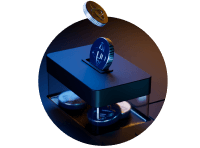What is a Heikin Ashi indicator?
How to read Heikin Ashi candlesticks charts
How to trade using Heikin Ashi
Heikin Ashi, which translates to 'average bar' in Japanese, is named so because it 'averages' the candles, smoothing out the price in a chart. This unique feature makes Heikin Ashi candles superior in showing trends and trend reversals. The Heikin Ashi indicator is plotted on the chart using an expert Advisor Indicator and can be installed on trading software such as MT4 and MT5. In this article, we will explain how the Heikin Ashi indicator works, how it is structured, and how to use its patterns in trading.
What is a Heikin Ashi indicator?
The Heikin Ashi indicator, available as an expert advisor on MQL5 for both MT4 and MT5, is a straightforward candlestick charting technique. It enhances trend visibility while filtering out market noise, making it a user-friendly tool for traders. It analyses price trends and gives signals in two different directions: trend strength and trend reversal.
The primary difference between traditional candlestick charts and Heikin Ashi charts is the calculation methods used to generate the candlesticks. This difference significantly impacts how traders interpret market trends and price movements.
How to calculate Heikin Ashi
Heikin Ashi consists of the following elements, each calculated using specific formulas:
| Component name | Description |
| Open (O) | This is the open price of a Heiken Ashi candle. It is calculated by taking the average of the opening and closing prices from the previous trading session. This means you add the two prices together and then divide by two. This average helps to smooth out price fluctuations. |
| Close (C) | It is a close price. It is determined by considering four factors from the current trading session: the opening, closing, highest, and lowest prices. By combining these values, the close price provides a comprehensive view of how the price has moved during the session. |
| High (H) | This is the high price of a Heiken Ashi candle. It reflects the maximum value reached during the current trading session. It is calculated by comparing the opening, the closing, and the highest prices of that session, helping traders see the peak level of activity. |
| Low (L) | This means a low price. It indicates the minimum value achieved in the current trading session. It is determined by looking at the opening, closing, and lowest prices recorded during the session. It shows the lowest point of market activity. |
Heiken Ashi uses one formula for its essential components. The first step is to collect the open-close (OC) data from the prior period and the open-high-low-close (OHLC) data from the current period to create a combo candlestick.
HA runs on the following calculations to create any candle:

1.
2.
a. High
b. Low
Heikin Ashi candle patterns
The HA candlestick, by filtering out the visual 'noise', provides a clear and uncluttered view of the trend. These patterns have distinct characteristics that make them easily identifiable on a chart, giving traders a visual advantage in interpreting market trends.
First, HA candlesticks have a long upper shadow and a small body. Second, the candlesticks are located at the top of an uptrend or the bottom of a downtrend. Finally, they are followed by a confirmation candlestick in the opposite direction.

Observing all these characteristics in a Heikin Ashi candlestick could signal a potential market reversal. When the Heikin Ashi candles are red, it typically means that prices are falling, indicating a downtrend, while blue candles suggest that prices are rising, signalling an uptrend. Traders who are attentive to these colour changes can be quick to respond to potential shifts in the market trend.
| Heiken Ashi candlesticks | Japanese candlesticks |
| A bullish candlestick is identified when the closing price is above the midpoint of the previous candlestick, suggesting continued upward momentum. | A bullish candlestick occurs when the closing price is higher than the opening price, indicating upward market movement. |
| A bearish candlestick is identified when the closing price is below the midpoint of the previous candlestick, indicating a prevailing downward trend. | A bearish candlestick occurs when the closing price is lower than the opening price, indicating downward market movement. |
How to read Heikin Ashi candlestick charts
Now, let's explore how to interpret the Heikin Ashi candlesticks.
If the candle's body is bullish, it indicates a bullish trend. If the candle's body is bearish, it reflects a bearish trend. Suppose the candle's body is thin, with wicks extending from both ends. In that case, it suggests market indecision, indicating that the market has stalled or is consolidating. The chart below shows market indecision as indicated by Heikin Ashi candles with spikes.

1. Uptrend
2. Reversal

When a strong trend is present, the candlesticks measure the strength of the current trend. The close price represents the average of all data points within the candle. Therefore, if the close price is significantly high, the market has intense bullish pressure. Upper wicks will begin to form when bullish momentum slows down, and bearish pressure starts to emerge.
We may apply the same principles in bearish conditions. In strong bearish trends, the candles will close lower within the candle range. A large candle range combined with a large candle body indicates strong momentum, while a small candle range combined with a small candle body signifies weak momentum.
Heikin Ashi candlesticks change noticeably when market conditions shift. The appearance of Heikin Ashi candles alters dramatically as price conditions change, enhancing chart readability. Generally, big-bodied candles indicate strong trending strength, while small double-wicked candles suggest poor trading conditions.
In a Heikin Ashi candlestick, the close price averages all candle data. Consequently, the close price of a Heikin Ashi candle differs from the current market price. As trends develop, Heikin Ashi candles build momentum off one another as prices move higher or lower. The disparity between the actual market price and the Heikin Ashi price can expand significantly.
This mathematical outcome can be beneficial because it discourages traders from buying at high prices and selling at low prices, a common mistake among novice traders. When the market stabilises, the gap between the actual price and the Heikin Ashi price will contract considerably.
Example
One significant benefit of Heikin Ashi charts is that they can help with the psychological aspect of reacting too quickly when prices go against you. For example, in the AUDCAD chart, you mostly see blue candles during a bullish trend. Only when the trend starts to reverse does a larger red candle appear. This clear visual can help traders avoid exiting their positions too early.


Advantages and disadvantages
The following advantages make Heikin Ashi an effective trading tool:
- It is easy to use. The indicator does not require software installation and can be applied across any trading platform, making it accessible to everyone.
- The candles produced by Heikin Ashi are more straightforward to interpret than traditional candlestick charts. This simplicity helps traders spot market trends and movements quickly.
- Many traders favour the Heikin Ashi indicator because it is known for providing reliable results. It utilises historical data to generate signals, which can enhance decision-making.
- Heikin Ashi helps traders minimise market noise, making it easier to identify trends. This smoothing effect can help traders more efficiently plan their entry and exit points in today's noisy markets.
- The technique can be applied across hourly, daily, and monthly timeframes.
- Heikin Ashi does not restrict the use of other technical indicators. By providing stronger signals regarding market movement, it can enhance the performance of existing indicators.
The Heikin Ashi technique also has some drawbacks that affect the analysis to an extent:
- It may not suit day traders or those seeking highly responsive indicators. The calculation involves averaging two values, meaning producing results takes longer.
- Heikin Ashi candlesticks do not provide transparent information about actual price levels. They only reflect average opening and closing prices. If you need actual prices, you'd better use other methods.
- Many traders look for price gaps to understand how strong a price movement is, decide when to enter a trade or set stop-loss orders to protect their investments. However, HA candlesticks don't show these gaps. To overcome this, traders can temporarily switch to traditional candlesticks during a trading session to get a clearer picture of price gaps.
How to trade using Heikin Ashi
The filtering effect of Heikin Ashi candlesticks provides a clear view of market structure and dominant trends. This clarity helps traders easily identify trends and spot reversal opportunities when trends fade.
Here are common tips for trading with Heikin Ashi:
- If you see blue candles with long upper wicks and big bodies, it's a sign that the upward trend is strong. In this case, you should reduce short positions and add to your long positions.
- On the flip side, the downward trend is strong if you see red candles with lower wicks and big bodies. Here, you should reduce your long positions and add to your short positions.
- Doji candles have small bodies with both upper and lower wicks, showing indecision in the market. This means a trend change is coming, so it's essential to look for additional confirmation before making any decisions.
- If you see long upper wicks, it suggests that more traders are starting to sell. Conversely, long lower wicks indicate that more traders are beginning to buy.
Final thoughts
- A Heikin Ashi indicator is a candlestick-based technique to help traders identify trends in the market.
- It gives signals about whether a trend is strong or changing direction. Blue candles indicate an uptrend, and red candles show a downtrend.
- If the colour of the candle changes, it can signal a potential shift in the market trend.
- Heikin Ashi is particularly useful for short-term trading strategies.
- However, caution is crucial because Heikin Ashi candles show average values, which means they might give a partial picture of the market's activity.












